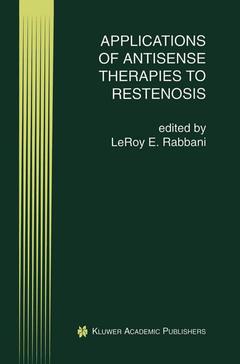Description
Applications of Antisense Therapies to Restenosis, Softcover reprint of the original 1st ed. 1999
Perspectives in Antisense Science Series, Vol. 3
Language: English
Subjects for Applications of Antisense Therapies to Restenosis:
Keywords
Stent; biology; cardiology; cell biology; genes; proliferation; vascular disease
Publication date: 10-2012
184 p. · 15.5x23.5 cm · Paperback
184 p. · 15.5x23.5 cm · Paperback
Description
/li>Contents
/li>
Restenosis, the proliferation of smooth muscle cells (SMC) that line blood vessels, often follows angioplasty. Despite advances in cardiology, restenosis continues to affect up to 40% of the over 500,000 patients who undergo angioplasty each year. Applications of Antisense Therapies to Restenosis is the first volume to address the potential of using antisense therapies to inhibit the restenosis that occurs after percutaneous transluminal angioplasty and coronary stenting. The work critically examines the application of various antisense therapies for inhibiting restenosis.
1 Restenosis: The Clinical Problem.- 2 The Pathobiology of Restenosis. A Paradigm from Clinical and Experimental Studies.- 3 Coronary Repair and Restenosis Cellular Basis for Antisense Approaches.- 4 Vascular Smooth Muscle Cell Biology and Restenosis.- 5 Vascular Antisense Therapy Directed Against c-myc, c-myb, and PCNA.- 6 Phosphorothioate Oligodeoxynucleotides as Inhibitors of gene Expression: Antisenseand Non-Antisense Effects.- 7 Molecular Therapies for Vascular Disease: Altering the Balance Between Cell growth and Cell Death.- 8 Oligonucleotides Containing the G-Quartet Sequence Motif.- 9 Non-G-Quartet, Non-Sequence Specific Antirestenotic Effects of Phosphorothioate Oligodeoxynucleotides.- 10 Local Delivery of Antirestenotic Drugs.- 11 Critical Considerations and Future Directions.
© 2024 LAVOISIER S.A.S.
These books may interest you

Complications in PTCA 105.49 €



